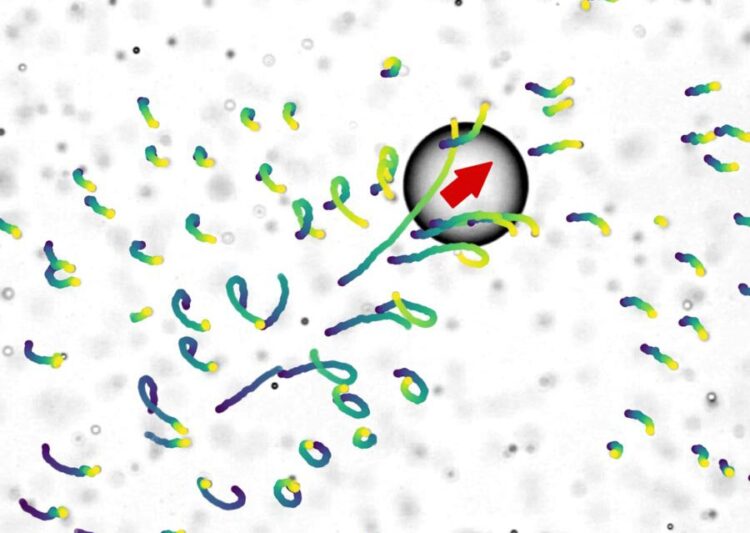Dragged along by micro-swimmers

An oil droplet micro-swimmer (moving in the direction of the arrow) is carrying along material from the surrounding. The colored lines show the movement of the cargo particles.
© MPIDS / Corinna Maaß
The entrainment of fluid near schooling, self-propelled particles can be utilized for directed transport.
Researchers from the Max Planck Institute for Dynamics and Self-Organization (MPIDS), the University of Pennsylvania and the University of Twente created a new model for a new transport mechanism on the microscale in a combined experimental and theoretical approach. They investigated small self-propelling objects, so-called micro-swimmers, and monitored a directed transport of particles in the surrounding fluid. Using this observation, they computed how a multitude of such swimmers can be able to induce a directed flow of material which could have an important impact on molecular transport mechanisms.
The transport of material is a key element in several both biological and technical applications. Micro-swimmers moving within a fluid are known to drag along their immediate surrounding liquid with them, including all particles and chemicals it might contain. This way, their self-propulsion causes material carried along to be distributed much faster compared to the mixing by diffusion over time. Especially in microscopic channels, a multitude of micro-swimmers moving into the same direction could therefore be used to transport particles in a directed manner. “Imagine that, instead of cramming all your holiday luggage into the car boot, you just drag it along in the surrounding air. It turns out that a swarm of microswimmers could actually do the very same with surprisingly high transport capacity.” reports Corinna Maaß, co-author of the study and group leader at the MPIDS.
Dragging along is more efficient than direct coupling
The researchers designed an experimental setup in which they placed an oil droplet in an aqueous solution between two glass plates creating a channel-like environment. Small plastic particles in the solution represented the material dragged along by the micro-swimmer droplet. Tracing these particles under the microscope revealed their net transport along with the moving oil droplet in the fluid.
Based on this experimental observation, their collaborator Arnold Matthijssen at the University of Pennsylvania created a model to compute the combined transport capability of a swarm of micro-swimmers. It was found that the capacity of the transported cargo particles could be greatly enhanced compared to a transport mechanism where the cargo is confined to the inside of the carrier.
The flower pot and the watering can
This observation relates to a common challenge in biology: To deliver drugs to certain places in the body, often carrier components are used. These drug transporting vessels typically possess a limited capacity and loading cargo into the transport vessels is often challenging. As shown in this new model, entraining the cargo by utilization of directed micro-swimmers might therefore be a possible alternative transport mechanism. Likewise, the model of collective entrainment can be applied to other confined spaces, such as carrying nutrients and signaling molecules deeply into complex networks or transport metabolic products at interfaces of porous media. Thus, it links the empirical observation of transport via micro-swimmers to the principle of efficient collective transport with many applications in biology and beyond.
“This principle is comparable to the soil in a flower pot” illustrates Corinna Maaß. “The soil constitutes a porous network with many channels for the water. In such a confined environment you might expect soil bacteria having problems dragging cargo along. Our study shows that in fact the opposite holds true: the compression of the flow inside the channels makes the entrainment even more efficient than if your bacteria just swim around freely in a watering can.”
Journal: Physical Review Letters
DOI: 10.1103/PhysRevLett.127.088006
Method of Research: Experimental study
Article Title: Collective Entrainment and Confinement Amplify Transport by Schooling Microswimmers
Article Publication Date: 18-Jul-2021
Media Contact
Manuel Maidorn
manuel.maidorn@ds.mpg.de
Office: +49 551 5176 668
Original Source
All latest news from the category: Life Sciences and Chemistry
Articles and reports from the Life Sciences and chemistry area deal with applied and basic research into modern biology, chemistry and human medicine.
Valuable information can be found on a range of life sciences fields including bacteriology, biochemistry, bionics, bioinformatics, biophysics, biotechnology, genetics, geobotany, human biology, marine biology, microbiology, molecular biology, cellular biology, zoology, bioinorganic chemistry, microchemistry and environmental chemistry.
Newest articles

Innovative 3D printed scaffolds offer new hope for bone healing
Researchers at the Institute for Bioengineering of Catalonia have developed novel 3D printed PLA-CaP scaffolds that promote blood vessel formation, ensuring better healing and regeneration of bone tissue. Bone is…

The surprising role of gut infection in Alzheimer’s disease
ASU- and Banner Alzheimer’s Institute-led study implicates link between a common virus and the disease, which travels from the gut to the brain and may be a target for antiviral…

Molecular gardening: New enzymes discovered for protein modification pruning
How deubiquitinases USP53 and USP54 cleave long polyubiquitin chains and how the former is linked to liver disease in children. Deubiquitinases (DUBs) are enzymes used by cells to trim protein…



